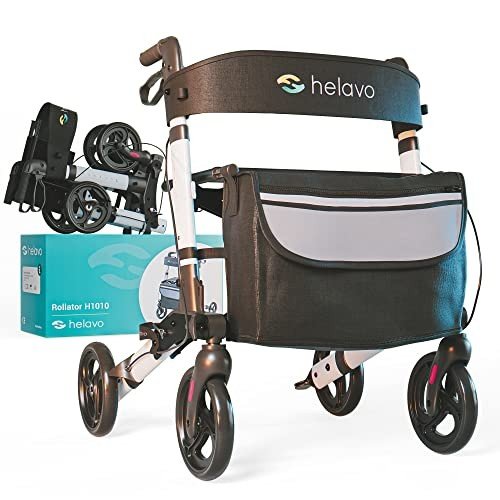Nine Things That Your Parent Taught You About How To Use A Rollator
페이지 정보
작성자 Mauricio Bethea 작성일25-06-21 18:57 조회10회 댓글0건본문

How To Use A Rollator: A Comprehensive Guide
Rollators are mobility aids designed to enhance the self-reliance and safety of people with mobility challenges. Unlike basic walkers, rollators are geared up with wheels, a seat, and typically a storage pouch, permitting users to move with greater ease and comfort. This article supplies a thorough guide on how to use a rollator efficiently and securely, guaranteeing a smoother and more satisfying walking experience.

What is a Rollator?
A rollator is a wheeled walking aid. It usually has:
- Three or 4 wheels: Offering stability and maneuverability.
- Hand brakes: For control while walking or when resting.
- A seat: Allowing users to take breaks easily.
- Storage area: Such as a basket or pouch for personal products.
Types of Rollators
There are various kinds of rollators, developed to satisfy the requirements of different users:
| Type | Description | Best for |
|---|---|---|
| 3-Wheel Rollator | Lighter and more compact, perfect for indoor use | Navigating tight areas |
| 4-Wheel Rollator | Deals stability and a larger seat, ideal for outdoor use | Longer strolls and heavier use |
| Heavy-Duty Rollator | Created to support more weight with additional robust functions | Users needing extra assistance |
| Pediatric Rollator | Smaller in size, adjusted for children | Children with mobility constraints |
How to Use a Rollator
Using a rollator properly is important to make sure safety and optimize the benefits it offers. Here's a step-by-step guide:
Step 1: Adjust the Height
Before using the rollator, it is essential to change the handlebars to the right height.
- Stand directly: With your arms relaxed at your sides.
- Procedure the height: The hand grips ought to be at wrist level when the user is standing.
- Secure changes: Ensure all locking mechanisms are securely engaged.
Action 2: Familiarize Yourself with the Rollator
Understanding the parts of the rollator will assist improve its usability.
- Brakes: Learn how to engage and release the brakes by squeezing the deals with.
- Seat: Identify where to sit conveniently when you need to rest.
- Storage location: Know where you can store personal belongings.
Action 3: Start Walking
- Position the rollator: Place it a step ahead of you, ensuring that the brakes are released.
- Grip the handles strongly: Keep a light stress in your arms while holding onto the rollator.
- Step inside the frame: Move forward by stepping with one foot and then the other.
- Maintain a straight posture: Walking need to be upright, avoiding the temptation to lean on the rollator exceedingly.
Step 4: Utilize Brakes
Always use the brakes efficiently to improve safety:
- To slow down: Gradually squeeze the brakes.
- To stop: Fully engage the brakes by pulling on both handles.
- To sit down: Ensure the rollator is stable, then thoroughly lower yourself onto the seat.
Step 5: Maneuver with Care
Turning and navigating can be difficult, so here are essential ideas:
- Telegraph your direction: Look where you want to go before turning.
- Take small steps: Move gently when turning to maintain balance.
- Use a three-point turn: Turn from one side to the other, keeping the walker close.
Action 6: Practice Stopping and Resting
Taking breaks is essential. Here are suggestions for resting:
- Find flat surface areas: Ensure the area is level when you sit.
- Engage the brakes when seated: This will prevent rolling.
- Shift position slowly: When all set to stand once again, eliminate the brakes before rising.
Maintenance and Safety Tips
To guarantee the rollator remains functional and safe:
- Regularly check the brakes: Ensure they engage and release correctly.
- Check wheel alignment: Wheels needs to not wobble; tighten up any loose screws.
- Tidy the rollator: Wipe down surfaces and get rid of debris from tires to preserve smooth operation.
Typical Concerns
Users might deal with numerous typical concerns when utilizing rollators. Here are some basic FAQs:
FAQs
Q1: Can I use a rollator outdoors?A: Yes, a lot of
rollators are developed for both indoor and outdoor use. Nevertheless, ensure it has the appropriate wheel size and tread for outdoor surfaces. Q2: What are the weight limits on rollators?A: Weight limits
normally vary by model, however durable rollators can generally accommodate users weighing around 300 to 500 pounds. Q3: Are rollators adjustable?A: Yes, a lot of rollators come with adjustable handle heights to accommodate users of numerous heights
. Q4: How do I transfer a rollator?A: Many rollators canbe folded for practical transport in an automobile. Constantly inspect the user handbook for specific folding guidelines. Q5: Can I use a rollator while recovering from surgery?A: Yes, many individuals use rollators during recovery to regain strength and balance, however ensure you follow your doctor's recommendations.
Understanding how to use a rollator properly can significantly improve mobility and reduce the threat of falls. Whether you are brand-new to using mobility aids or wanting to fine-tune your strategy, following the standards talked about in this article is important. With practice, a rollator can improve self-reliance while guaranteeing safety, therefore permitting users to take pleasure in a more active lifestyle.
댓글목록
등록된 댓글이 없습니다.




















